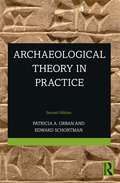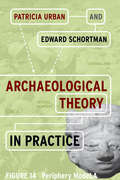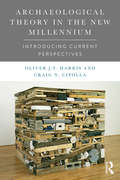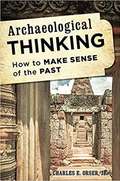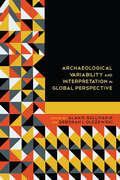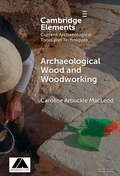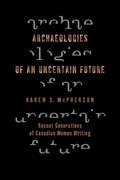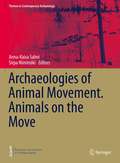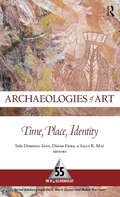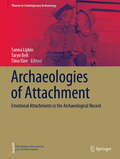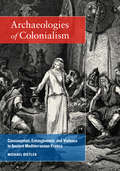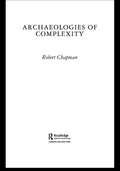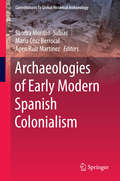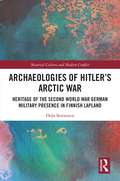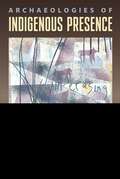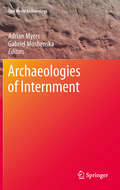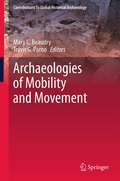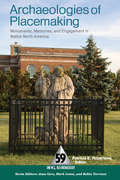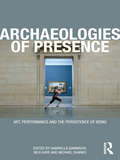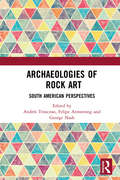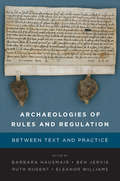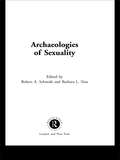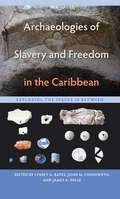- Table View
- List View
Archaeological Theory in Practice
by Edward Schortman Patricia A UrbanMany students view archaeological theory as a subject distinct from field research. This division is reinforced by the way theory is taught, often in stand-alone courses that focus more on logic and reasoning than on the application of ideas to fieldwork. Divorcing thought from action does not convey how archaeologists go about understanding the past. This book bridges the gap between theory and practice by looking in detail at how the authors and their colleagues used theory to interpret what they found while conducting research in northwest Honduras. This is not a linear narrative. Rather, the book highlights the open-ended nature of archaeological investigations in which theories guide research whose findings may challenge these initial interpretations and lead in unexpected directions. Pursuing those novel investigations requires new theories that are themselves subject to refutation by newly gathered data. The central case study is the writers’ work in Honduras. The interrelations of fieldwork, data, theory, and interpretation are also illustrated with two long-running archaeological debates, the emergence of inequality in southern Mesopotamia and inferring the ancient meanings of Stonehenge. The book is of special interest to undergraduate Anthropology/Archaeology majors and first- and second-year graduate students, along with anyone interested in how archaeologists convert the static materials we find into dynamic histories of long-vanished people.
Archaeological Theory in Practice
by PatriciaA UrbanIn this concise, friendly textbook, Patricia Urban and Edward Schortman teach the basics of archaeological theory, making explicit the crucial link between theory and the actual conduct of archaeological research. The first half of the text addresses the general nature of theory, as well as how it is used in the social sciences and in archaeology in particular. To demonstrate the usefulness of theory, the authors draw from research at Stonehenge, Mesopotamia, and their own long-term research project in the Naco Valley of Honduras. They show how theory becomes meaningful when it is used by very real individuals to interpret equally real materials. These extended narratives exemplify the creative interaction between data and theory that shape our understanding of the past. Ideal for introductory courses in archaeological theory.
Archaeological Theory in the New Millennium: Introducing Current Perspectives
by Craig Cipolla Oliver J. HarrisArchaeological Theory in the New Millennium provides an account of the changing world of archaeological theory and a challenge to more traditional narratives of archaeological thought. It charts the emergence of the new emphasis on relations as well as engaging with other current theoretical trends and the thinkers archaeologists regularly employ. Bringing together different strands of global archaeological theory and placing them in dialogue, the book explores the similarities and differences between different contemporary trends in theory while also highlighting potential strengths and weaknesses of different approaches. Written in a way to maximise its accessibility, in direct contrast to many of the sources on which it draws, Archaeological Theory in the New Millennium is an essential guide to cutting-edge theory for students and for professionals wishing to reacquaint themselves with this field.
Archaeological Thinking: How To Make Sense Of The Past
by Charles E. OrserHow do archaeologists think? How do they use the scattered and often-fragmentary remains from the past—both historical and excavated—to create meaningful, sensible interpretations of human history? In Archaeological Thinking, Charles E. Orser Jr., provides a commonsense guide to applying critical thinking skills to archaeological questions and evidence. Rather than critiquing and debunking specific cases of pseudo-archaeology or concentrating on archaeological theory, Orser considers the basics of scientific thinking, the use of logic and analogy, the meaning and context of facts, and the evaluation of source materials. He explains, concisely and accessibly, how archaeologists use these principles to create pictures of the past and teaches students to develop the skills needed to make equally reasoned interpretations.
Archaeological Variability and Interpretation in Global Perspective
by Alan P. Sullivan III and Deborah I. OlszewskiIn Archaeological Variability and Interpretation in Global Perspective, contributors illustrate the virtues of various ecological, experimental, statistical, typological, technological, and cognitive/social approaches for understanding the origins, formation histories, and inferential potential of a wide range of archaeological phenomena. As archaeologists worldwide create theoretically inspired and methodologically robust narratives of the cultural past, their research pivots on the principle that determining the origins and histories of archaeological phenomena is essential in understanding their relevance for a variety of anthropological problems. The chapters explore how the analysis of artifact, assemblage, and site distributions at different spatial and temporal scales provides new insights into how mobility strategies affect lithic assemblage composition, what causes unstable interaction patterns in complex societies, and which factors promote a sense of “place” in landscapes of abandoned structures. In addition, several chapters illustrate how new theoretical approaches and innovative methods promote reinterpretations of the regional significance of historically important archaeological sites such as Myrtos-Pyrgos (Crete, Greece), Aztalan (Wisconsin, USA), Tabun Cave (Israel), and Casas Grandes (Chihuahua, Mexico). The studies presented in Archaeological Variability and Interpretation in Global Perspective challenge orthodoxy, raise research-worthy controversies, and develop strong inferences about the diverse evolutionary pathways of humankind using theoretical perspectives that consider both new information and preexisting archaeological data. Contributors: C. Michael Barton, Brian F. Byrd, Gerald Cadogan, Philip G. Chase, Harold L. Dibble, Matthew J. Douglass, Patricia C. Fanning, Lynne Goldstein, Simon J. Holdaway, Kathryn A. Kamp, Sam Lin, Emilia Oddo, Zeljko Rezek, Julien Riel-Salvatore, Gary O. Rollefson, Jeffrey Rosenthal, Barbara J. Roth, Sissel Schroeder, Justin I. Shiner, John C. Whittaker, David R. Wilcox
Archaeological Wood and Woodworking (Elements in Current Archaeological Tools and Techniques)
by Caroline Arbuckle MacleodWood is, and always has been, one of the most common and versatile materials for creating structures and art. It is therefore also a ubiquitous element of the archaeological record. This discussion of the study of archaeological wood introduces a number of approaches to the analysis of these organic remains, including a brief overview of wood science, factors that impact the survival of wood materials, wood anatomy, and dendrochronology. These sections are intended to help archaeologists and other interested non-specialists prepare to encounter archaeological woods, and to understand the potential scientific data that these remains could contribute to our understanding of the human past. This is followed by additional approaches from the social sciences. The study of woodworking techniques and toolmarks, combined with ethnoarchaeology and experimental archaeology, can push wood analyses further. A combination of these approaches can help to create a more holistic view of humankind's relationship to wood.
Archaeologies of an Uncertain Future
by Karen McphersonIn Archaeologies of an Uncertain Future, McPherson explores the memory work, alternative historiographies, and feminist aesthetics by which women writers revisit the past and reimagine the future. Grounded within critical discourses across many discplines, McPherson's analysis engages contemporary discussions about autobiographical genres, post-modern historiographies, memoirs, and literary genealogies.
Archaeologies of an Uncertain Future: Recent Generations of Canadian Women Writing
by Karen McPhersonIn Archaeologies of an Uncertain Future, McPherson explores the memory work, alternative historiographies, and feminist aesthetics by which women writers revisit the past and reimagine the future. Grounded within critical discourses across many discplines, McPherson's analysis engages contemporary discussions about autobiographical genres, post-modern historiographies, memoirs, and literary genealogies.
Archaeologies of Animal Movement. Animals on the Move (Themes in Contemporary Archaeology)
by Anna-Kaisa Salmi Sirpa NiinimäkiThis book presents the state-of-the art in the analysis of animal movements in the past and its implications for human societies. It also addresses the importance of animal activity and mobility for understanding past human societies and past human-animal relationships through cases studies from different periods and areas. It is the first book to focus on the archaeology of animal movement on different scales – from fine-tuned muscle movements of working animals to feeding behavior and to long-distance movements across landscapes and regions.With the recent development of fine-tuned methodologies such as stable isotope analysis and physical activity assessment, the potential to understand how animals moved about in the past has increased substantially. While the chapters in the volume utilize a wide range of archaeological methods, they are all united by an emphasis on understanding animal activity and mobility patterns as something that has a major impact on human societies and human-animal relationships. Chapters in this volume show that animal activity patterns provide information on multiple aspects of human-animal relationships, including analysis of animal management practices, transhumance, global and regional trade networks, and animal domestication. This volume is of interest to scholars working in zooarchaeology and early human societies.
Archaeologies of Art: Time, Place, and Identity (One World Archaeology, Vol 55 Ser. #55)
by Sally K. May Inés Domingo Sanz Dánae FioreThis international volume draws together key research that examines visual arts of the past and contemporary indigenous societies. Placing each art style in its temporal and geographic context, the contributors show how depictions represent social mechanisms of identity construction, and how stylistic differences in product and process serve to reinforce cultural identity. Examples stretch from the Paleolithic to contemporary world and include rock art, body art, and portable arts. Ethnographic studies of contemporary art production and use, such as among contemporary Aboriginal groups, are included to help illuminate artistic practices and meanings in the past. The volume reflects the diversity of approaches used by archaeologists to incorporate visual arts into their analysis of past cultures and should be of great value to archaeologists, anthropologists, and art historians. Sponsored by the World Archaeological Congress.
Archaeologies of Attachment: Emotional Attachments in the Archaeological Record (Themes in Contemporary Archaeology)
by Taryn Bell Sanna Lipkin Tiina VäreThis edited volume offers a new approach to the study of emotion in the past, focusing on the experience of emotional attachment. Psychological research has demonstrated that all humans are capable of forming a variety of close social and emotional attachments from cradle to grave, yet archaeology has not, to date, considered the significance of these attachments in any detail. Inspired by Bowlby’s theory of attachment, one of the key theories in developmental psychology over the last 60 years, this volume sheds light on what attachment is, how it functions, and how it has influenced human life and material culture from the Palaeolithic to the present. This volume brings together contributions from authors focusing on a variety of subjects related to attachment, from social relationships with people and animals, to places, to material culture, from the deepest reaches of prehistory to the contemporary era. It aims to improve our understanding of where and how archaeologists can look for evidence of these attachments, and in doing so, it helps us to consider how these shape our understanding of human behaviour, cognition and life more broadly. This volume is of interest to archaeologists and scholars of social attachment theory.
Archaeologies of Colonialism
by Michael DietlerThis book presents a theoretically informed, up-to-date study of interactions between indigenous peoples of Mediterranean France and Etruscan, Greek, and Roman colonists during the first millennium BC. Analyzing archaeological data and ancient texts, Michael Dietler explores these colonial encounters over six centuries, focusing on material culture, urban landscapes, economic practices, and forms of violence. He shows how selective consumption linked native societies and colonists and created transformative relationships for each. Archaeologies of Colonialism also examines the role these ancient encounters played in the formation of modern European identity, colonial ideology, and practices, enumerating the problems for archaeologists attempting to re-examine these past societies.
Archaeologies of Complexity: The Later Prehistory Of South-east Spain, Iberia And The West Mediterranean (New Studies In Archaeology Ser.)
by Robert ChapmanAn up-to-date and critical analysis of how archaeologists study past societies, Archaeologies of Complexity addresses the nature of contemporary archaeology and the study of social change, and debates the transition from perceived simple, egalitarian societies to the complex power structures and divisions of our modern world. Since the eighteenth century, archaeologists have examined complexity in terms of successive types of societies, from early bands, tribes and chiefdoms to states; through stages of social evolution, including 'savagery', 'barbarism' and 'civilisation', to the present state of complexity and inequality. Presenting a radical, alternative view of ancient state societies, the book explains the often ambiguous terms of 'complexity', 'hierarchy' and inequality' and provides a critical account of the Anglo-American research of the last forty years which has heavily influenced the subject.
Archaeologies of Early Modern Spanish Colonialism (Contributions To Global Historical Archaeology)
by Sandra Montón-Subías María Cruz Berrocal Apen Ruiz MartínezArchaeologies of Early Modern Spanish Colonialism illustrates how archaeology contributes to the knowledge of early modern Spanish colonialism and the "first globalization" of the 16th and 17th centuries. Through a range of specific case studies, this book offers a global comparative perspective on colonial processes and colonial situations, and the ways in which they were experienced by the different peoples. But we also focus on marginal "unsuccessful" colonial episodes. Thus, some of the papers deal with very brief colonial events, even "marginal" in some cases, considered "failures" by the Spanish crown or even undertook without their consent. These short events are usually overlooked by traditional historiography, which is why archaeological research is particularly important in these cases, since archaeological remains may be the only type of evidence that stands as proof of these colonial events. At the same time, it critically examines the construction of categories and discourses of colonialism, and questions the ideological underpinnings of the source material required to address such a vast issue. Accordingly, the book strikes a balance between theoretical, methodological and empirical issues, integrated to a lesser or greater extent in most of the chapters.
Archaeologies of Hitler’s Arctic War: Heritage of the Second World War German Military Presence in Finnish Lapland (Material Culture and Modern Conflict)
by Oula SeitsonenThis book discusses the archaeology and heritage of the German military presence in Finnish Lapland during the Second World War, framing this northern, overlooked WWII material legacy from the nearly forgotten Arctic front as ‘dark heritage’ – a concrete reminder of Finns siding with the Nazis – and as polluting ‘war junk’ that ruins the ‘pristine natural beauty’ of Lapland’s wilderness. The scholarship herein provides fresh perspectives to contemporary discussions on heritage perception and ownership, indigenous rights, community empowerment, relational ontologies, and the ongoing worldwide refugee crisis.
Archaeologies of Indigenous Presence
by Tsim D. Schneider Lee M. PanichHighlighting collaborative archaeological research that centers the enduring histories of Native peoples in North AmericaChallenging narratives of Indigenous cultural loss and disappearance that are still prevalent in the archaeological study of colonization, this book highlights collaborative research and efforts to center the enduring histories of Native peoples in North America through case studies from several regions across the continent.The contributors to this volume, including Indigenous scholars and Tribal resource managers, examine different ways that archaeologists can center long-term Indigenous presence in the practices of fieldwork, laboratory analysis, scholarly communication, and public interpretation. These conversations range from ways to reframe colonial encounters in light of Indigenous persistence to the practicalities of identifying poorly documented sites dating to the late nineteenth century.In recognizing Indigenous presence in the centuries after 1492, this volume counters continued patterns of unknowing in archaeology and offers new perspectives on decolonizing the field. These essays show how this approach can help expose silenced histories, modeling research practices that acknowledge Tribes as living entities with their own rights, interests, and epistemologies.
Archaeologies of Internment (One World Archaeology)
by Gabriel Moshenska Adrian MyersThe internment of civilian and military prisoners became an increasingly common feature of conflicts in the twentieth century and into the twenty-first. Prison camps, though often hastily constructed and just as quickly destroyed, have left their marks in the archaeological record. Due to both their temporary nature and their often sensitive political contexts, places of internment present a unique challenge to archaeologists and heritage managers. As archaeologists have begun to explore the material remains of internment using a range of methods, these interdisciplinary studies have demonstrated the potential to connect individual memories and historical debates to the fragmentary material remains. Archaeologies of Internment brings together in one volume a range of methodological and theoretical approaches to this developing field. The contributions are geographically and temporally diverse, ranging from Second World War internment in Europe and the USA to prison islands of the Greek Civil War, South African labor camps, and the secret detention centers of the Argentinean Junta and the East German Stasi. These studies have powerful social, cultural, political, and emotive implications, particularly in societies in which historical narratives of oppression and genocide have themselves been suppressed. By repopulating the historical narratives with individuals and grounding them in the material remains, it is hoped that they might become, at least in some cases, archaeologies of liberation.
Archaeologies of Mobility and Movement (Contributions To Global Historical Archaeology #35)
by Mary C Beaudry Travis G. ParnoThis collection of essays in Archaeologies of Mobility and Movement draws inspiration from current archaeological interest in the movement of individuals, things, and ideas in the recent past. Movement is fundamentally concerned with the relationship(s) among time, object, person, and space. The volume argues that understanding movement in the past requires a shift away from traditional, fieldwork-based archaeological ontologies towards fluid, trajectory-based studies. Archaeology, by its very nature, locates objects frozen in space (literally in their three-dimensional matrices) at sites that are often stripped of people. An archaeology of movement must break away from this stasis and cut new pathways that trace the boundary-crossing contextuality inherent in object/person mobility. Essays in this volume build on these new approaches, confronting issues of movement from a variety of perspectives. They are divided into four sections, based on how the act of moving is framed. The groups into which these chapters are placed are not meant to be unyielding or definitive. The first section, "Objects in Motion," includes case studies that follow the paths of material culture and its interactions with groups of people. The second section of this volume, "People in Motion," features chapters that explore the shifting material traces of human mobility. Chapters in the third section of this book, "Movement through Spaces," illustrate the effects that particular spaces have on the people and objects who pass through them. Finally, there is an afterward that cohesively addresses the issue of studying movement in the recent past. At the heart of Archaeologies of Mobility and Movement is a concern with the hybridity of people and things, affordances of objects and spaces, contemporary heritage issues, and the effects of movement on archaeological subjects in the recent and contemporary past.
Archaeologies of Placemaking: Monuments, Memories, and Engagement in Native North America (One World Archaeology Ser. #59)
by Patricia E. RubertoneThis collection of original essays explores the tensions between prevailing regional and national versions of Indigenous pasts created, reified, and disseminated through monuments, and Indigenous peoples’ memories and experiences of place. The contributors ask critical questions about historic preservation and commemoration methods used by modern societies and their impact on the perception and identity of the people they supposedly remember, who are generally not consulted in the commemoration process. They discuss dichotomies of history and memory, place and displacement, public spectacle and private engagement, and reconciliation and re-appropriation of the heritage of indigenous people shown in these monuments. While the case studies deal with North American indigenous experience—from California to Virginia, and from the Southwest to New England and the Canadian Maritime—they have implications for dealings between indigenous peoples and nation states worldwide. Sponsored by the World Archaeological Congress.
Archaeologies of Presence
by Michael Shanks Gabriella Giannachi Nick KayeArchaeologies of Presence is a brilliant exploration of how the performance of presence can be understood through the relationships between performance theory and archaeological thinking. Drawing together carefully commissioned contributions by leading international scholars and artists, this radical new work poses a number of essential questions: What are the principle signifiers of theatrical presence? How is presence achieved through theatrical performance? What makes a memory come alive and live again? How is presence connected with identity? Is presence synonymous with 'being in the moment'? What is the nature of the ‘co-presence’ of audience and performer? Where does performance practice end and its documentation begin? Co-edited by performance specialists Gabriella Giannachi and Nick Kaye, and archaeologist Michael Shanks, Archaeologies of Presence represents an innovative and rewarding feat of interdisciplinary scholarship.
Archaeologies of Rock Art: South American Perspectives
by Andrés Troncoso Felipe Armstrong George NashRock art in South America is as diverse as the continent itself. In this vast territory, different peoples produced engravings, paintings, and massive earthworks, from the Atacama to the Amazon. These marks on the landscape were made by all different kinds of peoples, from some of the earliest hunter-gatherers in the continent, to the very complex societies within the Inca Empire. This book brings together the work of specialists from throughout the continent, addressing this diversity, as well as the variety of approaches that the Archaeology of rock art has taken in South America. Constructed of eleven thought-provoking chapters and arranged in three thematic sections, the book presents different theoretical approaches that are currently being used to understand the roles rock art played in prehistoric communities. The editors have skillfully crafted a book that presents the contribution the study of South American rock art can offer to the global research of this materiality, both theoretically and methodologically. This book will interest a broad range of scholars researching in archaeology, anthropology, history of art, heritage and conservation, as well as undergraduate and postgraduate students who will find interesting case studies showcasing the diverse ways in which rock art can be approached. Despite its focus on South America, the book is intended as a contribution towards the global study of rock art.
Archaeologies of Rules and Regulation: Between Text and Practice
by Barbara Hausmair, Ben Jervis, Ruth Nugent Eleanor WilliamsHow can we study the impact of rules on the lives of past people using archaeological evidence? To answer this question, Archaeologies of Rules and Regulation presents case studies drawn from across Europe and the United States. Covering areas as diverse as the use of space in a nineteenth-century U.S. Army camp, the deposition of waste in medieval towns, the experiences of Swedish migrants to North America, the relationship between people and animals in Anglo-Saxon England, these case studies explore the use of archaeological evidence in understanding the relationship between rules, lived experience, and social identity.
Archaeologies of Rules and Regulation: Between Text and Practice
by Barbara Hausmair Ben Jervis Ruth Nugent Eleanor WilliamsHow can we study the impact of rules on the lives of past people using archaeological evidence? To answer this question, Archaeologies of Rules and Regulation presents case studies drawn from across Europe and the United States. Covering areas as diverse as the use of space in a nineteenth-century U.S. Army camp, the deposition of waste in medieval towns, the experiences of Swedish migrants to North America, the relationship between people and animals in Anglo-Saxon England, these case studies explore the use of archaeological evidence in understanding the relationship between rules, lived experience, and social identity.
Archaeologies of Sexuality: Race And Sexuality In Colonial San Francisco
by Robert A. Schmidt Barbara L. VossStatus, age and gender have long been accepted aspects of archaeological enquiry, yet it is only recently that archaeologists have started seriously to consider the role of sex and sexuality in their studies.Archaeologies of Sexuality is a timely and pioneering work. It presents a strong, diverse body of scholarship which draws on locations as varied as medieval England, the ancient Maya kingdoms, New Kingdom Egypt, prehistoric Europe, and convict-era Australia, demonstrating the challenges and rewards of integrating the study of sex and sexuality within archaeology.This volume, with contributions by many leading archaeologists, will serve both as an essential introduction and a valuable reference tool for students and academics.
Archaeologies of Slavery and Freedom in the Caribbean: Exploring the Spaces in Between ( Florida Museum of Natural History: Ripley P. Bullen Series)
by Lynsey A. Bates John M. Chenoweth James A. DelleCaribbean plantations and the forces that shaped them--slavery, sugar, capitalism, and the tropical, sometimes deadly environment--have been studied extensively. This volume brings together alternate stories of sites that fall outside the large cash-crop estates. Employing innovative research tools and integrating data from Dominica, St. Lucia, the Dominican Republic, Jamaica, Barbados, Nevis, Montserrat, and the British Virgin Islands, the contributors investigate the oft-overlooked interstitial spaces where enslaved Africans sought to maintain their own identities inside and outside the fixed borders of colonialism. Despite grueling work regimes and social and economic restrictions, people held in bondage carved out places of their own at the margins of slavery's reach. These essays reveal a complex world within and between sprawling plantations--a world of caves, gullies, provision grounds, field houses, fields, and the areas beyond them, where the enslaved networked, interacted, and exchanged goods and information. The volume also explores the lives of poor whites, Afro-descendant members of military garrisons, and free people of color, demonstrating that binary models of black slaves and white planters do not fully encompass the diversity of Caribbean identities before and after emancipation. Together, the analyses of marginal spaces and postemancipation communities provide a more nuanced understanding of the experiences of those who lived in the historic Caribbean, and who created, nurtured, and ultimately cut the roots of empire. A volume in the Florida Museum of Natural History: Ripley P. Bullen Series
